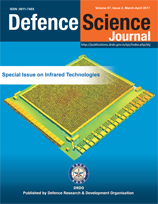FDTD Modelling of 1D Photonic Crystal comprised of Double Positive and Double Negative Metamaterial for Thermal Masking Application with CPML Absorbing Boundary Condition.
DOI:
https://doi.org/10.14429/dsj.67.9850Keywords:
Photonic crystal, Finite difference time domain, Zero-n? band gap, Double positive and double negative, Thermal imaging, Convolutional perfectly matched layerAbstract
Periodic structures of double positive and double negative metamaterial of thickness of λ/4 is designed to stop long-wave infrared and mid-wave infrared frequencies for masking from infrared detection devices. Band-gaps are obtained by calculating reflection and transmission coefficients at probe point close to the front and back faces of the periodic structure. 1D- finite difference time domain method is implemented in Matlab to study the electromagnetic wave propagation which is incident normal to a periodic stack of double positive and double negative metamaterial of having refractive indices of 9 and -6 respectively, at centre wavelength. Drude model is adapted to model double negative medium. Band-gap obtained are compared with the conventional photonic crystal by replacing the double negative medium with a double positive medium with the magnitude of refractive index same as that of double negative medium. Band-gap obtained confirms the presence of Zero-n͂ band-gap in DPS-DNG photonic crystal which is wider than the reflection band in conventional photonic crystal; nearly twice in mid-wave infrared region and five times in long-wave infrared region. A novel and highly efficient convolutional perfectly matched layer absorbing boundary condition is used to terminate the infinite computational finite difference time domain lattices.
Downloads
Published
How to Cite
Issue
Section
License
 Where otherwise noted, the Articles on this site are licensed under Creative Commons License: CC Attribution-Noncommercial-No Derivative Works 2.5 India
Where otherwise noted, the Articles on this site are licensed under Creative Commons License: CC Attribution-Noncommercial-No Derivative Works 2.5 India


